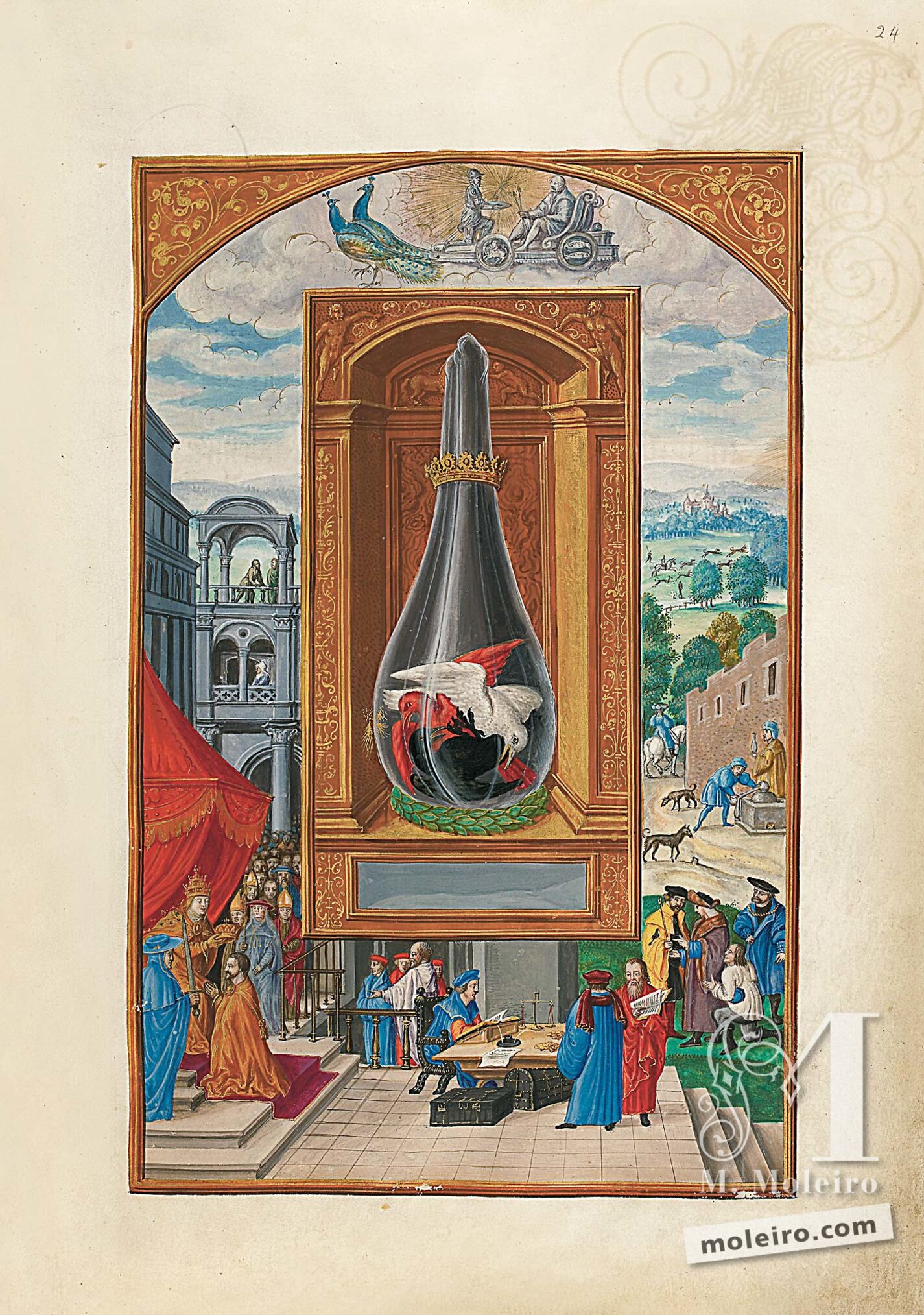Drawn by two peacocks, their tail feathers down, Jupiter’s planetary chariot navigates its way across the heavens. Holding two arrows as attributes in his right hand, the planetary god sits enthroned in his chariot while an aid, kneeling before him, offers him a bowl. The more noble circles of society fall under Jupiter’s rule, including the nobility and the clergy. The painter of the Splendor Solis expands this group to include alchemists, whom he depicts in the right midground in a state of industrious activity. Here, one of the adepts can be seen leaning over towards a helmet-shaped oven-top known as an alembic, while the other one inspects the flask he is holding in his left hand.
The left-hand side of the picture is occupied by a pigeon-blue palace building which is based on an engraving by Daniel Hopfer. Out the front of the building a pope seated beneath a red baldachin is crowning a new emperor. As is the case with several of the illustrations in the Splendor Solis, the coronation scene incorporates a number of details drawn from a woodcut in Hans Holbein the Younger’s series Bilder des Todes (Pictures of Death). Showing the emperor kissing the feet of the pope, Holbein’s woodcut “Der Bapst” (The Pope) signals the submissiveness of the secular world in the face of the church’s omnipotence. In the Splendor Solis, however, the emperor not only receives the crown with his head upright but is also endowed with the physiognomy of Charles v, who had just been crowned Holy Roman emperor in Bologna in 1530. This discovery is quite remarkable in an artistic sense insofar as the painter of the Splendor Solis took the liberty of updating the stereotypical pope and emperor featured in the original source of 1524-26 in order to capture the latest historical developments.
Set within the angular niche of the inserted panel is a glass flask upon a green laurel wreath. Inside the flask, three birds – black, white and red – are fighting with one another. This renewed allusion to the three principal colours of alchemy is discussed in the text that precedes it. The painter copied the motif of the three fighting birds from the alchemical illuminated manuscript of the Aurora Consurgens. It symbolises the separation of matter by heating, its subsequent purification in the next stage of transmutation, and, as will be seen in the following miniature, its fusion into one bird with three heads.
Jörg Völlnagel
(Art historian, research associate at the Staatliche Museen zu Berlin)

Drawn by two peacocks, their tail feathers down, Jupiter’s planetary chariot navigates its way across the heavens. Holding two arrows as attributes in his right hand, the planetary god sits enthroned in his chariot while an aid, kneeling before him, offers him a bowl. The more noble circles of society fall under Jupiter’s rule, including the nobility and the clergy. The painter of the Splendor Solis expands this group to include alchemists, whom he depicts in the right midground in a state of industrious activity. Here, one of the adepts can be seen leaning over towards a helmet-shaped oven-top known as an alembic, while the other one inspects the flask he is holding in his left hand.
The left-hand side of the picture is occupied by a pigeon-blue palace building which is based on an engraving by Daniel Hopfer. Out the front of the building a pope seated beneath a red baldachin is crowning a new emperor. As is the case with several of the illustrations in the Splendor Solis, the coronation scene incorporates a number of details drawn from a woodcut in Hans Holbein the Younger’s series Bilder des Todes (Pictures of Death). Showing the emperor kissing the feet of the pope, Holbein’s woodcut “Der Bapst” (The Pope) signals the submissiveness of the secular world in the face of the church’s omnipotence. In the Splendor Solis, however, the emperor not only receives the crown with his head upright but is also endowed with the physiognomy of Charles v, who had just been crowned Holy Roman emperor in Bologna in 1530. This discovery is quite remarkable in an artistic sense insofar as the painter of the Splendor Solis took the liberty of updating the stereotypical pope and emperor featured in the original source of 1524-26 in order to capture the latest historical developments.
Set within the angular niche of the inserted panel is a glass flask upon a green laurel wreath. Inside the flask, three birds – black, white and red – are fighting with one another. This renewed allusion to the three principal colours of alchemy is discussed in the text that precedes it. The painter copied the motif of the three fighting birds from the alchemical illuminated manuscript of the Aurora Consurgens. It symbolises the separation of matter by heating, its subsequent purification in the next stage of transmutation, and, as will be seen in the following miniature, its fusion into one bird with three heads.
Jörg Völlnagel
(Art historian, research associate at the Staatliche Museen zu Berlin)